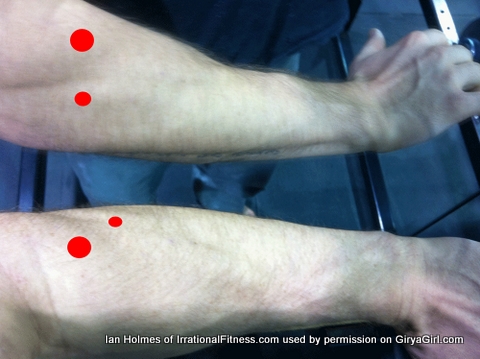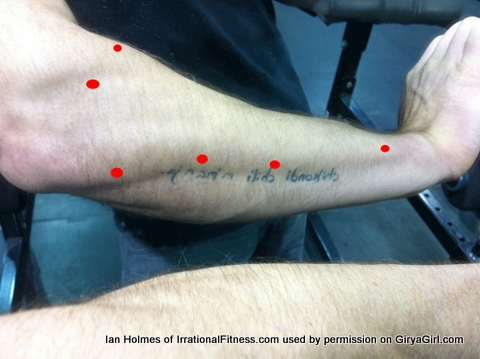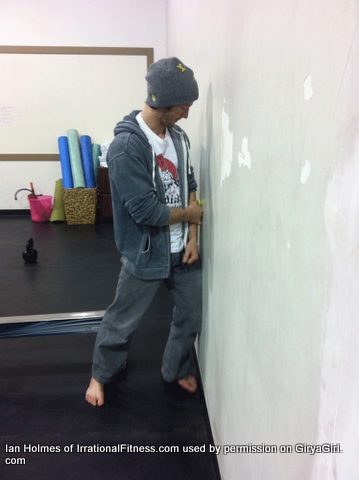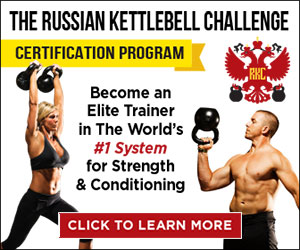
Ian Holmes, climber, ice climber, acrobat, gymnast, powerlifter, iconoclast, adventurer extrordinare, knocks out one arm chin ups like they’re nothing, swings & snatches the heaviest kettlebells without a flinch and has flawless hands at the end of a grueling 3-day RKC Workshop that leaves others nearly disfigured. (He was also quite the fashion rebel at the Chicago RKC, wearing the much-loved-among-women RKC tank top and somehow making it work.) You know I would have to track him down for you so we could hear about his holistic approach to something so very crucial to kettlebell and pull up, chin up, etc. training… HAND CARE. I asked him to write an article specifically for GiryaGirl.com – remember, you saw it here first!!!
Without further ado, Ian Holmes in his own words:
It is Sunday, we’re all tired yet have that strange sense of energy that comes when you have gone through something challenging with a group of people. Day three of the RKC, you glance around the room and see a much different group than the one that had exchanged the surface level meet and greets on a Thursday night that was a lifetime and three days ago. Tired, determined, happy, harder; we have been pushed as a group, and have been changed by it. Yet there is another common thread that has spread across the room. Taped hands. The ever present comment from attendees and coaches over the course of the weekend revolves around maintaining the hands, keeping hot spots, tears, blisters, and rips under control so that the RKC does not become a simple test of how much pain one can endure.My hands didn’t tear. In fact despite consistently choosing the heaviest bells I could, I didn’t suffer from anything even resembling a hot spot over the course of the weekend. Now a lot has been written on the topics of shaving down callouses, taping, proper use of chalk [and the choice of chalk you use], however there is a crucial item that has perhaps been overlooked. Hands tear because of poor technique; specifically in relation to gripping the bell. I know that some people were simply not used goose necking the bell down on a snatch, having trained with a corkscrew cast of the bell. Issues such as this are avoided simply by knowing the expectations of the instructors before hand, however once bells start dropping and hands start to tear one of the big culprits that needs to be examined is that of grip strength, and more importantly why it fails.
I come from a background of gymnastics, duo act aerial acrobatics, powerlifting, and climbing. In all cases grip strength will make or break your performance, and on occasion it is the sticking point between major injury and success. Again grip strength is an area that is covered in-depthly by a host of better and stronger men and women than myself. However very rarely does anyone take an in-depth look at how to maintain the soft tissue of the forearms in such a way that they can be abused with thousands of swings in a day and still be fine come the next day. These are the same tricks to apply if you are intending on training single finger one arm-pull-ups, heavy presses, or really any other form of training that is heavily grip dependent.
One of the issues many people face is that they are simply not used to an extensive training load packed into three days. It is a rare breed that find training for close to 10hrs a day to be normal. So it is that the soft tissue of the forearms when exposed to this kind of load in conjuncture with a decent number of contusions [come on, everyone is banging their forearms a bunch on cleans and snatches when they are being told to change their movement patterns] gets rather destroyed. The micro trauma that develops is commonly referred to as muscle knots, and by soft tissue therapists as trigger points. These are described as “hyper irritable spots in skeletal muscle that are associated with palpable nodules in taught bands of muscle fibers”[1], and have been shown to decrease the length of a muscle by keeping it slightly contracted, and by extension decrease overall muscle function while often leading to pain referral both locally and referred elsewhere. This is not good. This is especially true when these points are forming in all of the muscles you are using to hold on to a hunk of metal that you are accelerating through space.
The solution to this on a long term basis is to make friends with a soft tissue therapist, marry them, and demand that they work on your forearms, back, hips, and legs for the rest of your life. The short term solution for an RKC weekend, or if you aren’t very social is two fold; contrast baths, and site specific work using something like a golf ball, or if you are lying on your stomach for some reason, your own hands.
Lets deal with the easy item first. Contrast baths are a wonder that all pro athletes have known for years. In our case, you will need something you can immerse your arms in from the elbow down. Two sinks, a sink and a bathtub, two buckets, a hot-tub and a bucket, a trough… the options here are dependent on the size of your arms, and your creativity. Simply fill one with cold water and ice, and the other with warm water [I am told you don’t actually need scalding water, though I am still trying to convince people otherwise]. Immerse for one minute. Switch. Repeat until the ice is melted. This lovely bath is going to help flush blood in and out of the tissue in your arms, acting in some ways like an assisted pump moving waste away from the tissue, and fresh nutrient rich blood in. Good things indeed.
Second item. Local soft tissue work. Now I am going to preface the statement on self work with the fact that an actual masseuse who knows what they are doing will be able to help you here a lot if you have serious issues built up. You are unlikely to be willing to force yourself through the pain required to actually get out some of these deeply set issues, plus most people also have fascial issues, scar tissue, and generally tight muscles to deal with. Experts are good to have. What is more you are paying them to use appropriate leverage, and destroy their bodies to fix you. This is good. Doing work with your own fingers can result in you overworking the arm doing the work… and so forth. Hence why I recommend golf balls. They are cheap, hard, and rather portable.




So with that advice in hand go find yourself an article on developing grip strength. Put some time into getting your hands stronger, and learning some solid technique for your major kettlebell movements. Then apply these tips for maintaining the soft tissue of your forearms and hands and you will likely find that your grip gets stronger, your hands recover faster, and the tennis elbow and arthritis in your wrist was largely associated with tight muscles. Fix the muscles. Get stronger. Simple.
Oh and those of you who are unsure of what kind of grip program to work with… here is a sample grip workout that I have been playing with for the past few months as I prep for the Ice Climbing Worlds this spring. Feel free to adapt something similar to your strength and fitness levels. This is far from being the be all and end all of grip work that I do as a climber, but if grip strength is currently something that you don’t ever work on this could be a bit of a template for putting something together. If you are at a loss for where to go and are in desperate need of some progressions, I do know that the most recent Dragon Door release of Convict Conditioning 2 is supposed to have some decent grip work in there.
1a Fat bar deadlift 3, 3, 3, 3, 3
1b Towel Hang w/10s Pulls 1min, 1min, 1min, 1min, 1min
1c Hand-Stand finger tip pushups 5, 5, 5, 5, 5
2a Fat Bar deadlift singles 1, 1, 1, 1, 1
2b One arm hangs with engaged shoulder 30s [per arm], 30s, 30s, 30s, 30s
2c Fingertip pushups 10, 10, 10, 10, 10
2d Towel regrab w/ dynamic pull 3, 3, 3, 3, 3
Try it. Get stronger.
Ian Holmes, RKC
“The Carny”
www.irrationalfitness.com
UPDATE 2/12/2020: Read more from Ian Holmes at https://www.ascensioncalgary.com/articles/
*1 [Travell, Janet; Simons David; Simons Lois (1999). Myofascial Pain and Dysfunction: The Trigger Point Manual (2 vol. set, 2nd Ed.). USA: Lippincott Williams & Williams. ISBN 0-683-08363-5.]







Leave a Reply